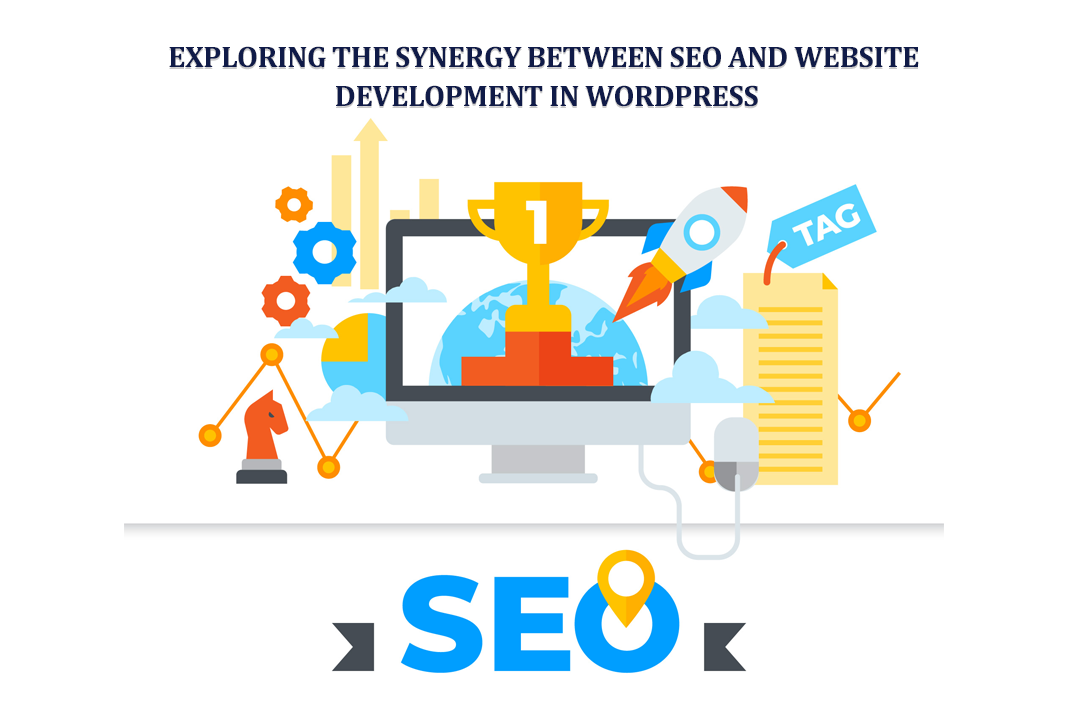
Table of Content:
In the bustling digital marketplace, standing out from the crowd can be daunting. For businesses and individuals alike, having a compelling online presence is essential. This is where two crucial elements, Search Engine Optimization (SEO) and website development, will help you. SEO guides your website towards visibility in search engine results pages (SERPs). On the other hand, website development builds the website itself, ensuring it’s mobile- and user-friendly.
However, their true power lies in their synergy – the combined effect of their efforts. Optimizing your WordPress website for user experience and search engine crawlers boosts rankings, attracts qualified traffic and helps achieve your online goals.
In this article, we’ll discuss building a solid foundation, WordPress SEO best practices, creating a user-centric website, and WordPress plugins for SEO and site development.
Building a Strong Foundation: Why SEO and Website Development Go Hand-in-Hand
In today’s competitive digital landscape, search engine optimization (SEO) and website development are critical in ensuring your online presence thrives.
SEO and its Key Elements
SEO involves optimizing your website to enhance its visibility for relevant keywords in search engine results pages (SERPs). It guides users to your valuable offerings using four key components. These include keyword research, on-page optimization, technical SEO, and off-page SEO. They are as follows:
- Keyword Research: It involves identifying the precise search terms your target audience utilizes to navigate the digital world.
- On-Page Optimization: For this, you need to meticulously tailor your website content, title tags, meta descriptions, and images to incorporate those keywords seamlessly.
- Technical SEO: It requires ensuring your website’s underlying code is immaculate, readily accessible, and easily crawlable by search engine bots.
- Off-Page SEO: It involves building a robust network of backlinks from reputable websites to yours. We’ll discuss these in more detail in the next section.
Website Development and its Impact on SEO
Website development shapes the user experience and lays the groundwork for Effective SEO Implementation. Some of its elements impact search engine algorithms:
- Website Structure and Navigation: A well-organized website with intuitive navigation guides users and search engines effortlessly through your content.
- Mobile-Friendliness: Search engines prioritize websites offering a seamless smartphone and tablet experience.
- Page Speed: Slow loading times frustrate users and incur penalties from search engines.
- Clean Code and Technical Best Practices: Website code riddled with errors or built on shaky foundations hinders search engine crawling and indexing.
The Synergy
When SEO and website development synergize, magic happens. By optimizing these interconnected elements, you create a website that’s user-friendly and engaging, sends strong SEO signals, and earns higher rankings for relevant keywords.
Thus, SEO and website development are not independent entities but complementary forces that must work in unison.
Optimizing for Search Engines: WordPress SEO Best Practices
Now that we’ve established a strong SEO and website development foundation, let’s delve into actionable strategies to optimize your WordPress website for search engine success.
The Power of Keywords
Keyword research is the cornerstone of effective SEO. By incorporating these keywords strategically into your content, you increase the likelihood of appearing in relevant search results. Utilize keyword research tools to uncover suitable keywords with high search volume and realistic competition levels.
Avoid keyword stuffing, which can harm your rankings. Instead, weave keywords effortlessly into your content, title tags, meta descriptions, and headers, ensuring a seamless reading experience.
You should use long-tail keywords. They’re longer, more specific phrases that often have lower competition and attract highly relevant traffic.
On-Page Optimization:
- Title Tags and Meta Descriptions: They act as your website’s storefront in search results. You must craft compelling titles that accurately reflect your content, entice clicks, and write descriptive meta descriptions that concisely summarize your page’s content.
- Headers and Subheaders: Structure your content with relevant headers and subheaders to improve readability for users and signal topic hierarchy to search engines.
- Image Optimization: This is also a part of on-page optimization. For this, use descriptive alt text to describe images.
- Internal Linking: This requires you to strategically link related pages within your website to enhance user experience, distribute link equity, and guide search engines through your content structure.
Technical SEO
Now, let’s talk about technical SEO. As discussed earlier, technical SEO involves mobile-friendliness and site speed optimization. Apart from that, it focuses on structured data and an XML sitemap.
Structured data is the code that helps search engines better understand your content and display it in rich snippets, enhancing visibility and click-through rates. Website owners can use plugins or tools to implement structured data for elements like articles, products, reviews, and events.
An XML sitemap guides search engines through your website’s structure and content, aiding in crawling and indexing.
High-Quality, Engaging Content
High-quality, engaging content is the heart of SEO success. This is because search engines prioritize websites that offer users valuable, informative, and relevant content. You must create content that aligns with your target audience’s interests and needs. For this, research their pain points, questions, and desires to craft content that genuinely resonates with them.
Why not diversify your content formats? You can offer a mix of articles, blog posts, infographics, videos, and podcasts to cater to different preferences and learning styles.
Additionally, prioritize readability and update your content regularly. You should use clear language, concise sentences, and proper formatting for the former. It will enhance user experience and keep visitors engaged.
With these tips for your content, your website will surely attract many new users and keep older users engaged.
Building a User-Centric Website: Web Development Strategies for Improved SEO
While SEO is crucial, it’s only part of the whole. Creating a website that delivers a brilliant user experience (UX) is equally essential. It becomes a potent force for online success when combined with strategic SEO approaches. Now, let’s explore how web development strategies for WordPress can enhance user engagement and your website’s search engine performance.
UX Design Principles
UX design principles go beyond visual appeal. They focus on creating an intuitive, seamless experience that guides users effortlessly through your website. By implementing these principles, you can increase engagement, reduce bounce rates, and boost conversion rates.
Website Structure and Navigation
A straightforward website structure is a roadmap that guides users to relevant information without confusion. You must organize your content logically and utilize categories and subcategories effectively, thus avoiding labyrinthine layouts.
Think of navigation as signposts pointing users in the right direction. Employ clear menu labels, visible search bars, and breadcrumbs to make finding desired content effortless. A well-organized structure and intuitive navigation make it easier for search engine crawlers to understand your website and index your content efficiently.
Putting It All Together: SEO and Website Development Plugins for WordPress
The next thing we’ll talk about is WordPress plugins. The WordPress ecosystem thrives on its robust selection of plugins. These handy tools can streamline and enhance your SEO journey, simplifying complex tasks and empowering you to focus on content creation and website management.
Some popular SEO plugins include Yoast SEO, Rank Math, and All in One SEO Pack. Each plugin has its strengths. How do you decide upon the plugin to use? For this, you need to consider the following factors:
- Website size
- Website complexity
- Budget
- Integrational capability
Many plugins complement SEO efforts by improving website performance and user experience. One example is the WooCommerce Stock Manager Plugin, which helps ensure users have a seamless experience by managing stock levels efficiently and preventing “out of stock” messages on product pages.
Plugins are valuable tools, but they’re not magical. Consistent content creation, high-quality website development, and a focus on user experience remain the cornerstones of SEO success. Website owners should use plugins to complement ongoing efforts, not replace them.
Conclusion:
You can craft a website that resonates deeply with your users by harnessing the potent synergy between SEO and website development in WordPress. Remember, user engagement and exceptional navigation are your goals, while technical SEO and keyword optimization help you on your journey. Utilize powerful plugins strategically, but always remember high-quality content creation and continuous improvement. So, start this journey with dedication, and watch your WordPress website flourish in the vibrant digital landscape.








